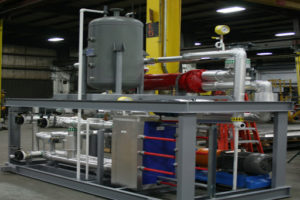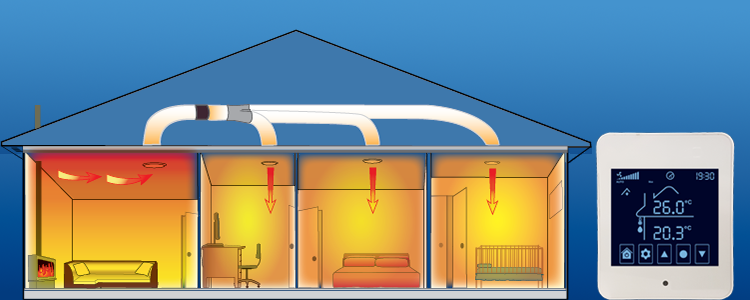Can DVS Heat Transfer Systems Help You Achieve Environmental Compliance Standards?
Wiki Article
A Comprehensive Guide to Picking the Right Heat Transfer Equipments for Your Requirements
Selecting the ideal Heat transfer system is important for functional efficiency. Various systems accommodate different requirements, influenced by variables such as temperature level range and liquid type. Comprehending the principles behind Heat transfer, such as radiation, convection, and conduction, is vital. Additionally, reviewing energy resources and maintenance techniques can impact long-lasting efficiency. A closer assessment of these considerations reveals how to customize a system to certain requirements. What should one prioritize in this complicated decision-making procedure?Understanding Heat Transfer: Secret Principles and Concepts
Heat transfer might seem like a simple idea, it includes a variety of principles that are essential for reliable system layout - DVS Heat Transfer Systems. Understanding these concepts is necessary for designers and engineers that intend to maximize thermal efficiency in numerous applications. Transmission, for example, includes the transfer of Heat through solid materials, while convection describes the activity of Heat within fluids. Radiation, one more essential principle, describes how Heat can be moved with electromagnetic waves. Each of these mechanisms plays an essential role in figuring out exactly how energy relocates within a system. By extensively comprehending these principles, experts can make informed decisions, making certain that Heat transfer systems operate efficiently and meet the details needs of their applications
Kinds Of Heat Transfer Systems: An Overview
Recognizing the concepts of Heat transfer prepares for discovering the numerous kinds of Heat transfer systems offered. Heat transfer systems can be classified largely into 3 kinds: radiation, transmission, and convection. Conduction entails Heat transfer via solid products, depending on direct call between particles. Convection, on the various other hand, happens in liquids (liquids and gases) where the movement of the fluid itself promotes Heat transfer. Radiation entails the transfer of Heat with electromagnetic waves and does not call for a medium, permitting it to occur in a vacuum cleaner. Each kind of system has distinctive qualities and applications, making it important for people and organizations to meticulously evaluate their specific requirements when picking the most appropriate Heat transfer service.Applications of Heat Transfer Equipments in Various Industries
Heat transfer systems play an important duty across different sectors, impacting effectiveness and product high quality. In commercial production processes, they help with specific temperature control, while in food and beverage handling, they assure safety and preservation. Furthermore, HVAC and climate control systems depend heavily on reliable Heat transfer to maintain comfortable environments.Industrial Manufacturing Processes

Countless industrial manufacturing processes depend heavily on effective Heat transfer systems to optimize performance and boost item quality. In markets such as metalworking, Heat exchangers play a crucial role in maintaining optimal temperature levels throughout welding, spreading, and building. These systems assure consistent Heat distribution, which is vital for achieving desired material properties. In the chemical production sector, Heat transfer systems promote specific temperature control throughout reactions, impacting return and safety and security. Furthermore, in fabric manufacturing, effective Heat monitoring is very important for dyeing and ending up procedures, influencing shade consistency and fabric top quality. By picking suitable Heat transfer modern technologies, makers can improve energy effectiveness and lower operational expenses, ultimately bring about a more lasting and competitive manufacturing environment.
Food and Drink Handling
Efficient Heat transfer systems are similarly essential in the food and beverage handling market, where keeping suitable temperatures is vital for food security and high quality. These systems play an important duty in procedures such as pasteurization, food preparation, and sanitation, guaranteeing that items are safe for usage and preserve their dietary worth. Heat exchangers, for example, efficiently transfer Heat between liquids, maximizing power use while decreasing temperature variations. In addition, refrigeration systems are essential for expanding and preserving disposable items shelf life. The selection of Heat transfer modern technology straight influences functional efficiency and product honesty, making it essential for food and beverage makers to pick the suitable systems tailored to their certain handling requirements. This mindful option ultimately contributes to consumer satisfaction and food safety.
Cooling And Heating and Climate Control
While several markets rely upon Heat transfer systems for performance, A/C (Home Heating, Ventilation, and A/c) plays a vital function in keeping indoor environment control across numerous settings. These systems use Heat transfer principles to control air, temperature, and moisture high quality, ensuring convenience and safety in household, commercial, and industrial settings. Appropriately designed heating and cooling systems boost power efficiency, minimize functional expenses, and lessen ecological impact. In commercial structures, as an example, efficient environment control adds to employee efficiency and consumer complete satisfaction. In commercial applications, cooling and heating systems help maintain suitable problems for tools procedure and item conservation. Selecting the ideal Heat transfer system is vital for meeting details climate control demands and accomplishing general system performance.Assessing Power Resources for Heat Transfer Systems
In assessing energy sources for Heat transfer systems, a comparison of eco-friendly power choices and fossil fuel factors to consider is essential. Eco-friendly resources, such as solar and wind, deal sustainable alternatives that can decrease environmental influence. On the other hand, fossil fuels stay prevalent due to their established facilities and energy thickness, motivating a cautious assessment of both alternatives.Renewable Power Options

Fossil Fuel Considerations
Evaluating fossil gas factors to consider is necessary for the efficiency and sustainability of Heat transfer systems. Fossil gas, such as gas, oil, and coal, are conventional power resources that offer significant Heat outcome, making them popular selections for residential and commercial applications. Nonetheless, their environmental impact, consisting of greenhouse gas emissions and source exhaustion, raises problems. When selecting a warm transfer system, it is vital to analyze the accessibility, cost, and regulative factors linked with these fuels. In addition, the effectiveness of nonrenewable fuel source systems need to be thought about, as greater efficiency can alleviate some environmental downsides. Ultimately, a well balanced approach evaluating efficiency and sustainability can direct decision-makers towards one of the most suitable Heat transfer solution for their particular demands.Factors to Think About When Picking a Heat Transfer System
Choosing an appropriate Heat transfer system needs mindful consideration of different aspects that can significantly influence performance and performance. One important aspect is the operating temperature level range, which dictates the products and layout ideal for the application. Additionally, the sort of liquid made use of in the system-- whether gas or fluid-- affects Heat transfer efficiency and compatibility. The system's size and capacity have to align with the particular requirements of the operation to stay clear of inadequacies. Power resource schedule is additionally vital, affecting operating expenses and sustainability. The setup environment, including space constraints and ease of access for maintenance, plays a significant duty in system option. Governing conformity and security standards must be considered to assure the system fulfills all legal requirements.Upkeep and Efficiency Optimization for Heat Transfer Equipments
Maintaining Heat transfer systems is necessary for ensuring maximum efficiency and long life. Routine upkeep activities, such as cleaning up Heat exchangers and examining insulation, help protect against effectiveness losses due to fouling and thermal bridging. In addition, checking system specifications, consisting of pressure and temperature, enables early discovery of anomalies, lessening downtime and costly fixings. Executing a preventive upkeep schedule can maximize performance and prolong the lifespan of parts. Additionally, upgrading to sophisticated control systems can boost operational performance by getting used to differing loads and problems. By focusing on maintenance and effectiveness optimization, drivers can achieve minimized power consumption, lower functional costs, and enhanced total system reliability, eventually bring about better resource use and a more sustainable operation.Future Fads in Heat Transfer Technologies
As industries progressively focus on sustainability and power efficiency, future patterns in Heat transfer innovations are readied to undergo considerable transformations. Developments such as sophisticated products, consisting of carbon nanotubes and nanofluids, guarantee enhanced thermal conductivity and performance. In addition, the combination of renewable power resources right into Heat transfer systems is obtaining energy, promoting eco-friendly services. Smart innovations, consisting of IoT sensors, are expected to reinvent tracking and control, allowing real-time data analysis for maximized efficiency. The advancement of portable and modular systems will help with simpler installation and upkeep, providing to varied applications. These innovations show a shift towards even DVS Heat Transfer Systems more lasting, effective, and adaptable Heat transfer remedies, lining up with international power objectives and ecological requirements.
Frequently Asked Inquiries
What Are the Environmental Impacts of Heat Transfer Equipments?
The environmental impacts of Heat transfer systems can include greenhouse gas exhausts, power usage, and potential thermal air pollution. Furthermore, improper disposal of ineffectiveness and materials can add to resource deficiency and environment disruption.Just how Do I Determine the Cost-Effectiveness of a Heat Transfer System?
To compute the cost-effectiveness of a heat transfer system, one have to examine initial costs, functional expenditures, maintenance needs, and energy performance, comparing these variables against the anticipated lifespan and efficiency of the system.Can Heat Transfer Solution Be Used in Residential Setups?
Heat transfer systems can certainly be made use of in property settings. They give reliable heating and cooling down remedies, making homes a lot more comfy while potentially reducing power costs. Their convenience enables numerous applications in domestic settings.What Safety Regulations Put On Heat Transfer Equipments?
Security laws for Heat transfer systems usually consist of standards on maintenance, setup, and operation. Compliance with local building ordinance, producer specs, and sector standards is vital to ensure risk-free and effective system efficiency in numerous applications.Just How Do Various Products Affect Heat Transfer Effectiveness?

Conduction, for circumstances, entails the transfer of Heat with strong materials, while convection refers to the motion of Heat within liquids. Understanding the concepts of Heat transfer lays the groundwork for checking out the numerous types of Heat transfer systems readily available. Heat exchangers, for instance, effectively move Heat between fluids, optimizing power usage while minimizing temperature level changes. In evaluating energy sources for Heat transfer systems, a comparison of sustainable power alternatives and fossil fuel considerations is essential. Metals, such as copper and aluminum, conduct Heat properly, whereas insulators like rubber and glass slow down Heat flow.
Report this wiki page